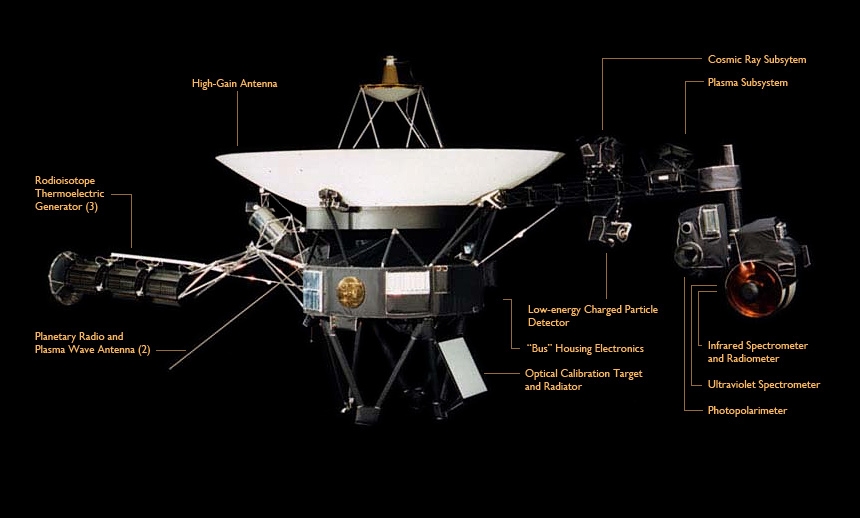What this cache is:
This is a cache representing the Voyager 1 spacecraft, a 1,592 lb robotic space probe of the outer Solar System and beyond. It is located approximately 268 miles from the Vgr1 - Sun cache in Concord, CA. This represents the approximate scale distance of Voyager 1 from the Sun as of January 2016.
Voyager 1

Voyager 1 was launched September 5, 1977. It remains operational, currently pursuing its extended mission to locate and study the boundaries of the Solar System, including the Kuiper belt and beyond. Its original mission visited Jupiter and Saturn; and it was the first probe to provide detailed images of the moons of those planets.
This is one of the bonus caches in a series that creates the model of the Solar System with objects along the I-680, I-80, I-505, I-5 route that would be taken if heading for the Oregon border. All caches are within 3 miles (as the crow flies) of that route. Parking for this cache is available within 500 feet. The coordinate accuracy was +/- 10 feet at the time of the reading. The elevation is approximately 2,500 feet. Keep that in mind when attempting this in the Winter where snow conditions may limit access. The container itself is a regular sized ammo can.
The Sun for the Vgr1 Solar System Model is located, of course, at Sun Valley in Concord and is named Vgr1 - Sun. All objects are placed at a distance from Vgr1 - Sun relative to their average orbital distance (+/- 5%). The scale used is 2 miles for every Astronomical Unit. An Astronomical Unit (AU) is the average distance between the Sun and the Earth. With this scale, Neptune, the farthest planet, is in the range of 59.5 to 60.9 miles distant. Eris, the farthest dwarf planet, is in the range of 128.6 to 142.1 miles distant. Sorry folks, Pluto is now classified as a dwarf planet and is in the range of 75.0 to 82.9 miles distant.
Prerequisite:
To find the cache, you must have found all 15 object caches (the sun, the 8 planets, the 5 dwarf planets, and the asteroid belt), and collected the number associated with the coordinate code letters from each of those caches.
What to do if you have found all 15 object caches:
The cache is located at: North JK PR.STW and West ABC DE.FGH. To derive the final coordinates for you search, do the following math (the small letters correspond to the value you recorded when you found the other 15 caches):
- A = a - 0
- B = b - 0
- C = c - 0
- D = d + 3
- E = e - 1
- F = f - 3
- G = g + 1
- H = h - 5
- J = j + 0
- K = k + 0
- P = p - 1
- R = r +5
- S = s - 1
- T = t - 5
- W = w - 7

You can validate your puzzle solution with certitude.
If you can't get the coordinates to come out right, recheck your work and try again. If you are still having problems, send me a message with the coordinates you derived and the data values you used for the coordinate code letters.
Why the difficulty rating of 4.5?
This cache has a difficulty rating of 4.5 due to the large amount of travel required to reach it (over 600 miles total for most folks.) The cache itself, if it were just a single-stage, would have a difficulty rating of 1.5. If you do your homework, it is possible to do this entire series in one (long) day. The total round trip from the Vgr1 - Sun cache to the Voyager 1 (November 2013) cache is some where between 600 - 700 miles, depending how often you double back to for missed exists, find other caches, etc.
Upon placement, the cache contained:
- Log book (bring your own writing instrument)
- FTF grand prize: Gas money (rounded to the nearest whole dollar) to travel 425 of the 1,300 miles at 25 miles per gallon at $0.19 / gallon (1951 gas price) OR at $3.53 / gallon (2013 gas price). You'll have to decide which it is and is it worth it to make the trip. Could truly be either, but not both.
- DVD: Voyager: To The Final Frontier
Why is the cache located in this area?
As of January 2016, Voyager 1 was at a distance of 133.85 AU (approximately 12.4 billion miles) from the Sun, which makes it the most distant human-made object from Earth. At the above distance, light or radio waves, which travel at 670,616,629 miles per hour, take over 18.6 hours to reach the Earth from Voyager 1. As a basis for comparison, the Moon is about 1.4 light-seconds from Earth, the sun is approximately 8.5 light-minutes away, and the nearest star is 4.3 light-years away. As of May 2008, Voyager 1 was traveling at a speed of 38,400 miles per hour. At this speed, I should be placing an additional cache called "Vgr1 - Voyager 1 (March 2018)" when it crosses the I-5 California border into Oregon.
Other stuff:
Please consider visiting the other caches in the Vgr1 Solar System Model. This link will take you to a list of the Vgr1 caches. You may also pick from the table below.
For more information on Voyager 1, visit its Wikipedia description.
For more information on the Solar System, visit its Wikipedia description.
The idea was inspired by TeamJiffy's great series I finished at the end of 2008; Northern CA Solar System Model: Comet Halley
Congratulations to ???????? on First to Find (FTF).
Special Thanks:
I want to say a special thanks to the following cachers that have agreed to act as maintenance backup for this cache.